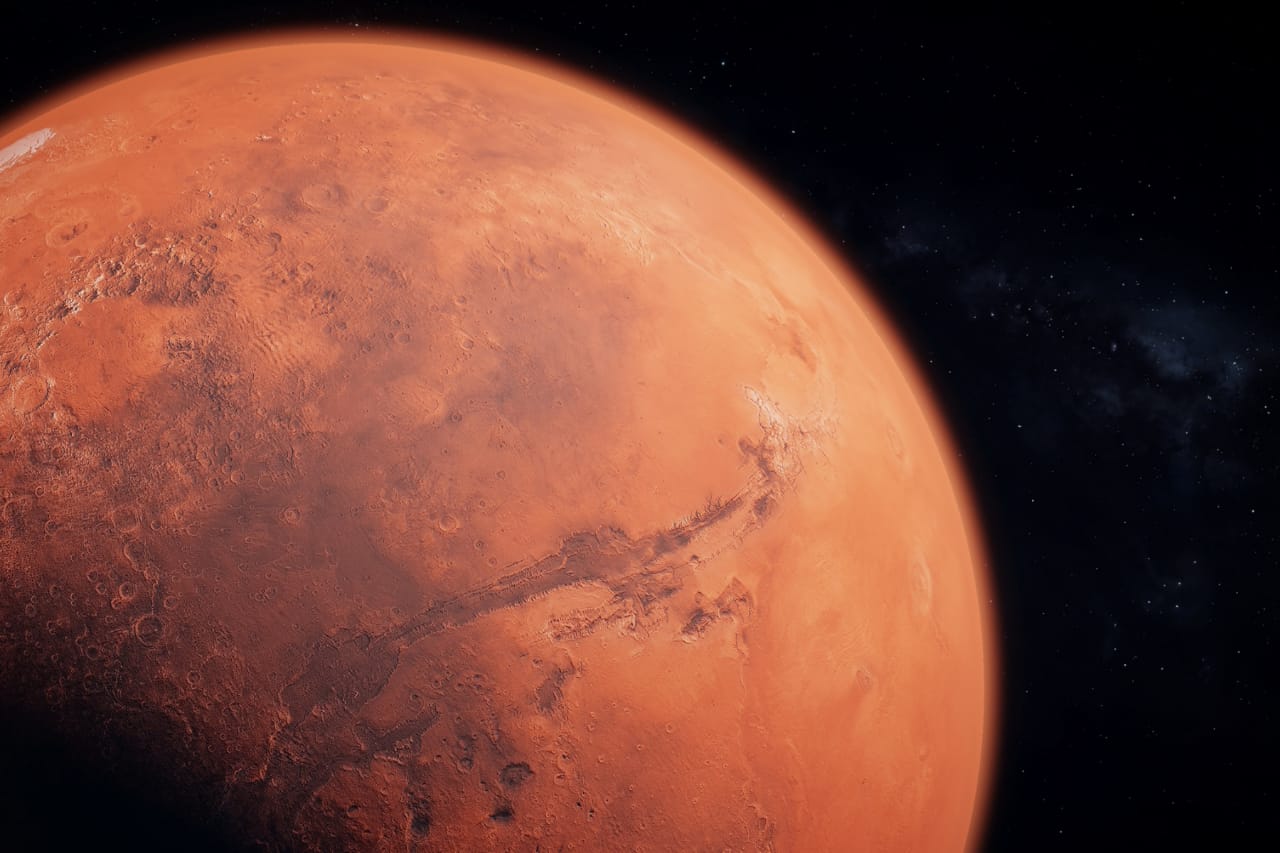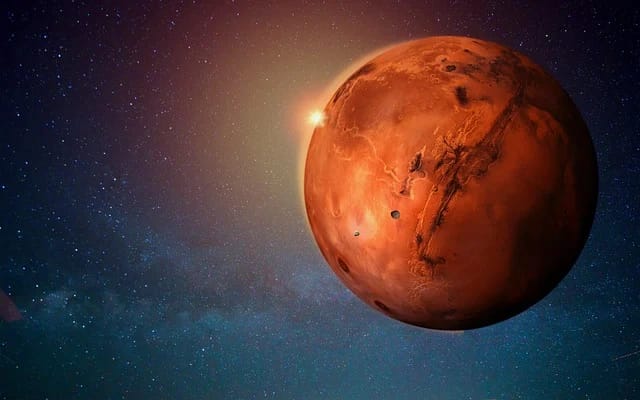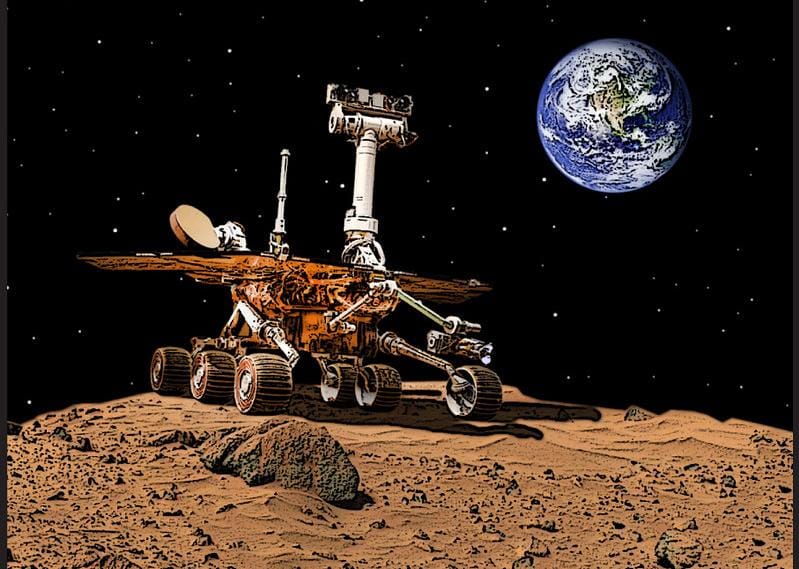Mars has been a mystery for our world! Known as the Red Planet, Mars has been the centre of exploration for a long period. For its dark red colour, the Romans named it Mars after their god of war. For a long duration, space has been our long-ranging final frontier. But as the explorations advanced, explorers and scientists have been on the keen urge of exploring Mars. This article will be explaining the various results we have got from our explorations and what do we know about Mars from past exploration!
Mars is the fourth planet from the Sun and just more than half the size of Earth. Its gravity is just 38% of Earth’s gravity. One year on Mars is around 687 Earth days, but a day on it is just 40 minutes more than an Earth day. This is due to the fact that Mars has a larger orbit than Earth but rotates faster about its axis.
Humans have always been interested in star-like objects in the sky. The reddish tint of the planet made Mars quite apart from its counterparts. In the 1800s, with help of telescopes, it was found that its surface had features like landforms which suggested that it was a civilisation that was wrong. Now with explorations, we have learned that 3.5 billion years ago, the red giant might have been as lively as the Earth today.
Space organisations around the globe have been planning missions for Mars for further explorations. Till the time, it’s our turn to let you know about what do we know about Mars from past exploration!
1. Surface of Mars
The primary thing visible is the red colour of the planet. This rusty colour is due to the iron-rich minerals in its dust and rocks covering the surface. NASA believes that the iron mineral on the surface oxidises to form rust and give it the characteristic red colour. When scientists look at the surface and its features, they sense it as the work of flowing liquids. This clearly suggests that the planet once inhabited an ocean in the Northern hemisphere. It was also likely that it was wrapped by a thick atmosphere that was capable of holding liquid water.
2. Atmosphere
The atmosphere of Mars is cold and thin which doesn’t allow the existence of liquid water on the surface. Missions have been going on to check whether the planet has water in the form of ice caps under the surface or not. The atmosphere is composed of carbon dioxide and doesn’t support life. Methane gas also appears in the atmosphere. The atmosphere is about 100 times less dense than Earth but still supports weather, clouds and winds, although it varies seasonally. In the past, it was much thicker and supported liquid water. With time, the lighter particles escaped as Mars does not have a global magnetic field. This affected the atmosphere and it became thinner.
3. Composition and Structure
- Chemical composition – it is composed of iron, sulphur and nickel. The crust is made up of a rock called basalt.
- Atmospheric composition – It is composed of 95% carbon dioxide, 2.7% nitrogen, 0.13% oxygen, 1.6% of argon and some amounts of water, nitrogen oxide, neon, krypton and xenon.
- Magnetic field – Mars has no global magnetic field, but certain regions have 10 times higher magnetic field than Earth.
- Internal structure – Researchers believe that the core of Mars is between 3000 to 4000 km in diameter, its mantle is about 5400 to 7200 km wide while the crust is 50 km in thickness.
4. Other Physical Characteristics
The planet homes the highest mountain, deepest valley and longest valley in the entire solar system. Valles Marineris is a system of valleys that is as deep as 10 km and runs for around 4000 km, covering almost one-fifth of Mars. The Olympus Mons is the highest mountain at 27 km high, nearly three times that of Mount Everest. It also has the largest volcanoes in the solar system, Mons being one of them which is 600 km in diameter. Mars also has a huge number of craters with the Southern hemisphere having more of them than the Northern. The largest crater of the planet is in Southern Hemisphere which is 2300 km wide and named Hellas Planitia.
5. Climate of Mars
For its greater distance from the Sun, Mars is much colder than Earth. The average temperature on Mars is around -60 degree Celsius. It can vary from about -125 degree Celsius at the poles in winter to 20 degree Celsius at noon around the equator.
6. Signs of life
A recent study conducted in 2018 found that salty water under the surface could consist of oxygen in considerable amounts. This could support microbial life. But it depends highly on the temperature and pressure. This could mean that life once existed on Mars or still does. Methane was also found in the atmosphere which is the simplest organic molecule and could be the clue for life. The discovery of methane in localised forms is a great breakthrough as the major source of methane production on Earth is microbial life meaning there could be microbial life on Mars as well.
7. Moons of Mars
Mars has two moons – Phobos and Deimos. Both these moons are carbon-rich and are covered by dust and loose rocks. They are very small as compared to our moon and are irregular in shape. Phobos is about 27 km wide and Deimos, about 15 km.
Previous Mars Missions
Humans since the 1960s have sent their space-crafts to the Red planet for exploration purposes. But sending a spacecraft to Mars is a tough task and landing on it is even tougher. The atmosphere of the planet is the major reason for this which makes the descent quite difficult. Thus far, more than 60% of the missions to land on Mars have failed.
Till now, the NASA, Soviet Union, the European Space Agency, the Indian Space Research Organisation, UAE and China have successfully entered the Martian orbit. NASA and China, both have successfully landed their rovers on the surface with China recently landing its rover.
- NASA’s Mariner 4 was the earliest mission that brought identification to this anonymous world and captured close images in 1965.
- In 1971, Soviet Union sent its Mars 3 spacecraft into orbit which sent various information regarding the planet. It also tried to land a lander to the surface but it lost contact after 20 seconds.
- In 1976, the Viking 1 and 2 by NASA were the first spacecraft to operate on the Martian surface. They kept sending important information and photos till 1982.
- In 1996, NASA’s Mars Pathfinder mission landed the first rover on Mars. This was followed by the Spirit and Opportunity, which sent more than 10000 images and explored the planet but soon their powers were cut in 2010 when a dust storm damaged their solar panels.
- Several other missions by NASA, ESA’s Mars Express and Trace Gas Orbiter and India’s Mars Orbiter are sending in crucial information regarding the planet.
All these missions are paving the way to extensive research regarding the planet and contribute to a major portion of our answer to what do we know about Mars from past exploration! They send us crucial information that Mars is an active planet that may support life.
What future Mars missions are on the way?
There are a bunch of missions that are in line for further exploration of Mars. Robotic missions to Mars have had success in the past few decades but with the current technology, it would be still a challenge to land people on Mars. It would take several months to travel to Mars, meaning they have to live for several months in microgravity which has its effects on the human body. NASA is planning to land its astronauts on the surface of Mars in the 2030s. It is developing a special space capsule, Orion that will be able to ferry humans to the moon and beyond.
Sooner or later, the human race will develop the method and technology to know whether the neighbouring planet hosted life or will it be able to support any life in the future.
Conclusion
Mars is our neighbouring planet and since it was explored, missions have been constant. Several countries and space organisations have tried their hands at it, many of which have failed quite miserably but many of them have been successful and have provided important information regarding Mars. What do we know about Mars from past exploration, is still an ongoing question since explorations are still in continuation and will keep going on till we get all our answers. Humans are curious creatures and this curiosity might one day lead us to our neighbouring planet.


